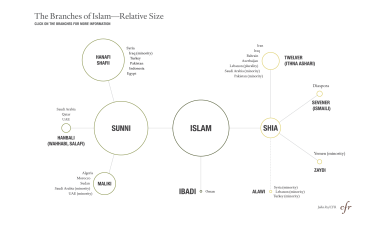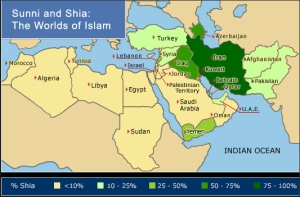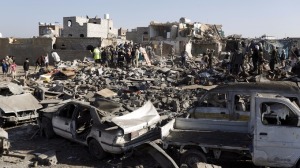The Yemeni people have been under the constant threat of death since the Saudi Arabian led coalition began the bombing of its neighbour in March 2015. Saudi Arabia began their air strikes against the country in an effort to influence the outcome of the Yemeni Civil War. Spearheading a coalition of nine Arab states, Saudi Arabia have imposed an aerial and naval blockade in Yemen in a military intervention code-named Operation Decisive Storm.
The intervention began when the internationally recognized but domestically contested Yemeni President Abd Hadi requested for assistance against a Houthi tribal offensive aimed at the capital city of Aden. Hitherto, President Hadi has fled to Saudi Arabia and the Saudi led coalition has continued to launch airstrikes against the Houthis and those loyal to former Yemeni president Ali Abdullah Saleh, who was deposed in the 2011 Arab Spring uprisings.
The situation in the Muslim Middle-East is not as complicated as it may seem. Essentially we are witnessing a war of dominance between two branches of Islam; Sunni and Shi’a.
Sunni is the largest branch of Islam and dominates most countries in the region; Saudi Arabia, Qatar, United Arab Emirates, Kuwait, Bahrain and Jordan are all indisputably Sunni led states, although some of these countries do contain sectarian tensions; there are a mix of both Sunni and Shi’a Muslims living in each of the aforementioned states.
On the other hand, governments/monarchies that profess Shi’a can be found in Iraq, Iran, Lebanon and Yemen, although many of these countries also contain sectarian tensions. The Sunni’s and Shia’s are in conflict about who would lead the Muslim community after the Prophet Muhammad’s death.
Essentially, the Sunni states that are involved in the intervention in Yemen (Saudi Arabia, Egypt, Morocco, Jordan, Sudan, the United Arab Emirates, Kuwait Qatar and Bahrain) are doing so in order to halt a Shi’a backed coup in the region. The United States has also drastically increased its weapons supplies to these coalition states whilst also supplying intelligence and logistical support. Arms sales in the region of billions of dollars have been sold to the coalition states by the United States.
Last Sunday at least five people were been killed and 10 others injured after a “projectile” hit a hospital supported by Medecins Sans Frontieres in northern Yemen in what has been deemed as a violation of humanitarian law. It is believed that many others may still be trapped beneath piles of rubble.
Medecins Sans Frontieres (MSF) who are also known as Doctors Without Borders claim that “According to our staff on the ground, at 9:20am one projectile impacted the Shiara Hospital in the Razeh district where MSF has been working since November 2015.”
MSF have stated that the attacking coalition led by Saudi Arabia, know the GPS coordinates of all medical facilities in Yemen including ones where MSF doctors practice.
“There is no way that anyone with the capacity to carry out an airstrike or launch a rocket would not have known that the Shiara Hospital was a functioning health facility providing critical services and supported by MSF,” said Raquel Ayora, MSF director of operations.
“Bombing hospitals is a violation of international humanitarian law,” she said.
The war in the region has so far seen more than 6,000 people killed including over 2,800 civilians, with the majority of them dying due to air strikes, according to the United Nations. The Shiara hospital is the third MSF facility to have been bombed in Yemen in less than three months. Dozens of medical facilities have been destroyed or damaged in the conflict due to Saudi-led airstrikes as well as poorly placed shelling by the Houthis and their allies.
The Shiara hospital hit on Sunday lies in the Razeh district of Saada province. Saada is known as a stronghold of the Houthis which the coalition has been fighting and the region has been home to some of the fiercest bombardment in Yemen. The destruction of the hospital has left hundreds of thousands of Yemenis in the area without access to medical treatment for war injuries as well as diseases such as malaria.
The aerial and naval blockade implemented by the Saudi-led coalition has left the country in dire straights. Import restrictions on basic goods have led to an ever widening humanitarian crisis with over 80% of the population of Yemen now in need of basic assistance. Last month, the US ambassador to the United Nations, Samantha Powell ironically tweeted about the “grim” humanitarian situation in Yemen despite the hypocrisy due to the role played by the US in the war. The USA has so far refused to push for accountability in the war by holding its own investigations into airstrikes.
Yemen’s capital city of Sanaa has been one of the most attacked cities in the region. According to Human Right’s Watch US manufactured cluster bombs have been dropped in neighborhoods in the capital. In addition to this, coalition warplanes have struck a wedding hall, a center for the blind and the city’s chamber of commerce.
Yemen’s pro-Saudi government have seemingly turned their backs on their citizens; the Yemenis government recently expelled a UN human rights envoy over what it called “unfair statements.” The expulsion came after Rupert Colville, the spokesperson for the U.N. Office of the High Commissioner for Human Rights criticised the “terrible toll on civilians” during the conflict. The expulsion of the official caused an uproar and the government begrudgingly reversed their decision two days later.
Peace talks which were expected to be held in mid-January have been postponed until the end of the month after a rejection by the Houthis. Adam Baron, a founding member of the Sanaa Centre for Strategic Studies has stated that whereas both political sides; the coalition and the Houthis think they’re winning, it is the Yemenis people who are paying the price of the conflict “with a deepening humanitarian crisis, destruction of infrastructure, and the unraveling of the country’s entire social fabric.”


